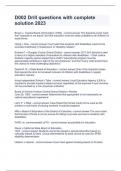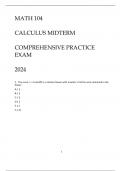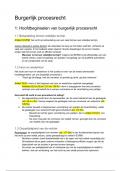integration
Lesson 1: introduction migration and integration
Migration and integration
Migration = highly politicised debate But what is the meaning of these words?
Who is a migrant? What is integration? Who is responsible for it? Do we live in an unprecedented era
of migration? What are the laws governing the movement of people globally and locally? How does
society change and react to people moving in and out? How are social boundaries shaped and
reshaped by mobility?
Many disciplines – interdisciplinary
Different disciplinary perspectives: History, Law, Sociology, …and the look on migration depends on
disciplinary backgrounds.
Challenge: draw on these different approaches and build a critical understanding of migration,
mobility and integration.
Lesson 2: Migration: a historical perspective
Some terminological issues
Migration = internal and international migration not only people crossing international borders
because in the past there were no borders. If we want to speak about migration, we also have to
think about people changing residence.
Time frame of this historical perspective:
Early modern period: 1500-1800 French revolution was important.
Modern period: 1800-1914
Why a Historical Perspective?
Looking from a social perspective, adopting a historical perspective provides a deeper
understanding of contemporary phenomena. This is particularly true when examining migration and
its relationship with the modernization paradigm.
,Migration and the Modernization Paradigm
Karl Polanyi's 'The Great Transformation' highlights fundamental changes in the 19th century,
challenging the perception of a stable and immobile past. The "revolt of the early modernists"
disputes the "myth of the immobile peasant," asserting that migration was not absent before the
19th century. In the 'modern' era, characterized by industrialization, urbanization, demographic
growth, a transport revolution, and rural proletarianization, significant societal changes occurred.
The labor market became more integrated, contributing to the rise of the urban poor. In the
nineteenth century, migration was viewed as a new and predominantly one-directional phenomenon
—from rural areas to cities. This migration was often described as 'miserable,' reflecting the
challenges and hardships faced by those moving from rural to urban environments.
Zelinski's Transition Model
Zelinski's demographic transition model links migration to demographic shifts:
First Phase: Limited and
circular migration in pre-modern societies.
Second Phase: Rising mobility in early transitional societies.
Third Phase: Rural exodus and international emigration decline in late transitional societies.
Fourth Phase: Advanced societies witness city-to-city migration and immigration.
Migration and the Modernization Paradigm Critique
Critics, such as Charles Tilly, argue that the mobility transition is not universal, ahistorical, and
wrongly associates modernization with migration. Already migration in 16th century due to free
labour market. There was a constant movement to cities. Leslie Page Moch emphasizes that
migration is a continuous phenomenon deeply embedded in social and economic frameworks.
Problem: Transport and Communication Evolution means…
Examining the historical evolution of transport and communication means reveals significant
developments from waterways to airplanes and letters to the internet. Intermediaries, like travel
agencies and smuggling networks, played crucial roles in facilitating or restricting migration.
,Critiquing the Mobility Transition: Quantification
Quantifying the mobility transition challenges common assumptions. Studies reveal high mobility
before industrialization and complexities in migration patterns.
Comparison between migration before 19 th
century and after after it became a lot more,
it was always there but rose in the 19th century.
Studying Migration in the Past
Understanding migration in the past involves considering factors like transport, information channels,
and individual motives.
The distance moved by migrants is influenced by several factors. Firstly, it depends on transport
possibilities and costs, making accessibility a key determinant. Information channels play a crucial
role at the 'meso' level, shaping migrants' awareness and choices. Motivations for migration are
often divided between aspirations and realizations. While some migrants have a preconceived idea of
what to expect in their new location, the actual reality may differ. Who moved and where the move
depends on individual and family characteristics? In which direction they move depends on social
networks and access to information and communication channels
Migration is viewed as an adaptive strategy operating at macro, meso, and micro levels.
Macro-level factors: encompass structural characteristics like labor market dynamics and
demographic changes, constituting push and pull factors.
Meso-level factors: involve social networks, familial connections, and relationships.
Micro-level factors: pertain to individual characteristics such as age, education, and cultural
background. The interplay of these levels influences the opportunities available for migrants,
shaping their migration experiences.
Role of Historians
Historians play a crucial role in providing a long-term perspective, avoiding misinterpretations
rooted in the modernization paradigm, and linking migration to broader economic, demographic,
and political processes
,Migration and Urbanization
Examining urbanization trajectories and the relationship between migration and urban growth
provides insights into historical patterns of population movement.
The growth of urban populations has been a consistent trend throughout history, reflecting the
overall expansion of the human population. This urbanization trajectory began in the Middle Ages
and has continued to increase over time.
Around 1800, particularly in Western Europe,
Japan, and some parts of the Middle East, a
significant number of people were already
residing in cities. Migration and urbanization
experienced notable expansion during the
period from 1800 to 1850, as evidenced by
studies conducted by J. & L. Lucassen.
Migration to cities played a crucial role in this urbanization process, especially in the 1800s. Cities
relied on migration to counterbalance the challenges posed by high mortality rates within urban
areas.
Macro-level factors, such as economic cycles and shifting economic centers in Europe, contributed
to the evolution of hierarchical urban networks. For instance, the 15th and 16th centuries saw
prominence in Italian and Spanish cities, followed by a shift to Northwestern Europe, including cities
like Antwerp in the 16th century, Amsterdam in the 17th century, and London and Hamburg.
Demographically, migration served as a key regulator of city populations before 1800. The "Urban
graveyard effect" highlights the net effect of migration contributing to urban growth. Fast-growing
cities, such as Amsterdam in the 17th century and London in the 17th and 18th centuries, witnessed
a majority of inhabitants born outside the city walls.
For example, examining Amsterdam's population dynamics between the 17th century and 1930
reveals a decrease in the number of foreign-born citizens. However, by 2010, there was an increase,
emphasizing the historical significance of foreign-born citizens, particularly during the city's 17th-
century boom.
,Migration to Cities
If you want to describe pre-industrial migration (before 19the century) and you look to the distance
travelled, the gender-ratio, local interaction of migrants you can make a distinction between long-
distance migrants and Hinterland migrants.
Long – distance migrants = migrants who move and cross borders and do more distance
Hinterland migrants = migrants who move from near the city, they move short distances
The increased migration to cities during this period can be attributed to several factors. One
significant contributor was the European Marriage Pattern and individual life cycles. Female
migrants often opted for shorter distances to marry, influencing the urbanization trend by
contributing to the growing population in cities.
Simultaneously, the processes of proletarianization played a crucial role. As people became mobile
laborers, the search for work drove increased mobility, drawing individuals to urban centers where
economic opportunities were more abundant.
The nature of migration during this time exhibited various layers, encompassing permanent, semi-
permanent, and seasonal movements. This multi-layered approach highlighted the diverse and
dynamic nature of population mobility towards urban areas.
However, the real extent of mobility was often underestimated. Seasonal patterns of labor
migration played a significant role, contributing to a high turnover of the population. Migration was
not limited to a unidirectional flow from rural hinterlands to cities; instead, it took on a more
nuanced character, involving movement in many directions. Cities experienced rising mobility, not
only in terms of migration from rural areas but also in movements between cities and even migration
out of urban centers.
Cities attracted migrants for various reasons, including seasonal migration, economic cycles, shifting
economic centers, and the regulation of labor markets.
Migration and gender
The feminization of migration is observed historically, with women migrating for sex work, marriage,
and domestic roles. Women are important in the long-distance migration because they were
(mainly) the first low-skilled people who started to migrate over longer distances. These days some
people talk about the feminisation of migration because women from all over the world come to
Europe to work. this isn’t new since last decades.
Migration Regulation: Walls, Gates, and Papers
Migration policies have historically been a focal point in shaping the movement of people, and the
focus on national states in social and political sciences, particularly during the 19th and 20th
centuries, has been pronounced. However, this perspective presents challenges when viewed from a
historical standpoint.
In the pre-industrial period, the determination of the distinction between 'citizens' and 'foreigners'
was more influenced by cities than states. Cities exercised autonomy in policy-making at the urban
level, involving various multi-layered institutions such as guilds, brotherhoods, and neighborhoods.
The concept of 'belonging' to urban 'communitas' played a crucial role, leading to different access to
citizenship within cities.
,Cities, driven by three primary concerns, regulated migration to maintain social order:
1. Regulation of Labor Market:
Migration was often encouraged to stimulate the labor market, providing access to labor
through guilds and corporations.
Cities aimed to attract 'useful' migrants based on economic needs.
2. Management of Local Resources - Social Policy:
Access to social support depended on local belonging, creating distinctions between migrants
and citizens.
During economic crises, cities faced decisions on 'deserving' versus 'undeserving poor,'
impacting social support eligibility.
3. Maintenance of Political Stability - Public Order:
Concerns included factors like religion, vagabonds, beggars, and political revolutionaries.
Differentiation between 'wanted' and 'unwanted' migrants was part of a segmented migration
system.
The regulation model varied over time, with cities implementing different approaches depending on
the historical period.
The transition from urban gates and walls as boundaries in the early modern period to national
borders in the modern era marked significant changes. The demolition of city gates and walls in the
19th century paved the way for national regulations, distinguishing between internal and external
migrants. This shift serves as a material illustration of changes in governance.
Despite these changes, cities remain crucial in migration regulation, acting as primary gateways for
migrants. While cities lost much of their formal power to regulate migration since the 19th century,
urban authorities still play a role in implementing and influencing national policies. For example,
social assistance remained a local responsibility until the 20th century, emphasizing the ongoing
importance of urban administrations in identifying, monitoring, and registering the movement of
people.
The evolution from urban gates to national borders highlights the complex interplay between
historical and modern migration policies. The use of identification and registration documents, such
as passports, became tools for control and surveillance of population and mobility, reflecting both
top-down practices and bottom-up forms of entitlement and claims-making.
Concluding Remarks
Adopting a historical perspective on migration offers a long-term view, corrects misinterpretations,
and aids in understanding migration as a dynamic and continuous process. Interdisciplinary
collaboration is essential to comprehensively study migration across different time periods. Historical
studies emphasize the complexity of ethnicity, assimilation processes, and the multifaceted nature of
migration.
,Les 3: Theories of migration
To start it’s important to say that there is no grand theory of migration. there is no theory that
explains everything. We do have a few theories that can explain some examples of migration and
theories that can explain other examples.
These different theories start from different assumptions and have different levels of analysis with
their own thematic focus.
Macro: economic, demographic, socio-cultural, political factors
Meso: family arrangements, networks, communities
Micro: individuals ‘dispositions, attitudes, representation, desires etc.
Different theories for different kinds of migration
Internal vs international
Forced vs voluntary.
There is a receiving country bias = theory mostly constructed from the point of view of the receiving
state. They don’t worry about the countries people leave from. They try to explain immigration.
Different types of models or theories
There are different types of models that describe migration on different levels of society:
Functionalist/push-pull models
Neo-classical and human capital theories (Macro and Micro)
Historical-structural theories
New economics of labour migration and livelihood approaches (Meso-level)
Migration network theory (Meso)
Migration system theory
Migration transition theories
Theories of migrant incorporation: assimilation and integration
,Functionalist/ push-pull models
What does the model/ theory say/believe?
Push Pull
Population density Availability of land
Environmental, economic and
demographic factors “pushing” Demographic growth Economic opportunities
and “pulling” individuals.
Lack of economic opportunities Demand for labour
Social forces tend towards
equilibrium. Political repression Political freedom
Criticism on push-pull theories:
Descriptive theory they don’t explain why things happen; they only describe it.
E.g. War can push people out – or block people in war not only a push factor.
Not clear how different factors interact together to produce an effect.
E.g. No change in opportunities but change in the perceptions about standards of life
and horizons of possibilities.
Deterministic they don’t consider the choice of human beings in why they would move or
not.
E.g. People do not migrate from the poorest countries to the richest… almost never
the case, they migrate to countries that start to develop.
,Neo-classical and human capital theories (Macro and Micro)
What does the model/ theory say/believe?
Migration = a positive thing: trough labour migration, the system continues to be in balance
People are expected to migrate if the benefits of migrating (mostly
calculated in wages) are greater than the cost of migrating.
Highly skilled and young people tend to migrate more.
Looking to invest in their human capital.
Reason to invest in their migration and human capital: benefits
in the long run.
Selectivity of migration explained.
not an action/process which everybody goes through, some people are more likely than
others.
Criticism on neo-classical models
Are human beings purely rational actors?
Perfect knowledge: migrants can decide where to go, based on perfect information of their
opportunities in a country mostly this information is not accessible.
Perfect forecasting of cost and benefits of staying or migrating to a multiplicity of
destinations is hard.
what about national regulations and borders? Not everyone can move.
what about access to money and information. Not equal to all
Human agency? Perceptions? Representations? Families?
Historical-structural theories
What does the model/ theory say/believe?
Migration is one of the consequences of capitalist penetration and the unequal trade developed
between developed and undeveloped countries.
Assumption is different: the market is not self-regulated, there is no balance, there is a
Marxist approach.
Marxist approach: the market is the result of the interest of elites (the dominant groups)– it
produces inequalities across places, classes, people.
In the historical-structural theories we can include the Dependency theory (Frank 1969) and
World System Analysis (Wallerstein, 1974) (core vs peripheries)
focused on large scale recruitment of labour in colonial times, post war period (e.g.
Italians in Belgium after WWII- "200 kg of coal per miner per day”)
No free choice
Traditional economic structures have been undermined by capitalist globalization and
multinational penetration in local economies– uprooted peasants becoming proletariat
– while capitalist cumulate more capital and land.
Some Implications of historical-structural theories
, Migration is seen as deepening uneven development the development of uneven development,
because:
Brain drains – brain waste.
Brain drains smart/intelligent people with certain skills who leave to other countries.
Brain waste: smart/intelligent people who left their country and start working in a
sector in the new country where they can’t use their skills.
Exploitation of natural resources in the global south for the welfare of Global North
Providing cheap labour force to rich economics
SEGMENTED LABOUR MARKET THEORY = an example of a historical structural theory it says
that industrial market is made out of two labour markets
Primary and secondary labour market:
Highly skilled labour force (primary)
Lower skilled labour force (care, catering, cleaning, constructing, assembly line, etc)
(secondary)
Why lower skilled labour force needed? Women entering the labour force and kids
going to school.
Polarisation within global cities – rich district with finance services and managers vs
peripheries rich labour and poor labour
De-regularisation of the labour market
High unemployment and migration migrants who can be exploited easily get the
jobs.
Criticism on historical – structural theories:
No agency – deterministic they don’t talk about the capability to choose.
All migrants are exploited victims … but some are doing well.
The myth of the immobile peasant
The more inequalities the more migration – not true: migration is boosted by development.












